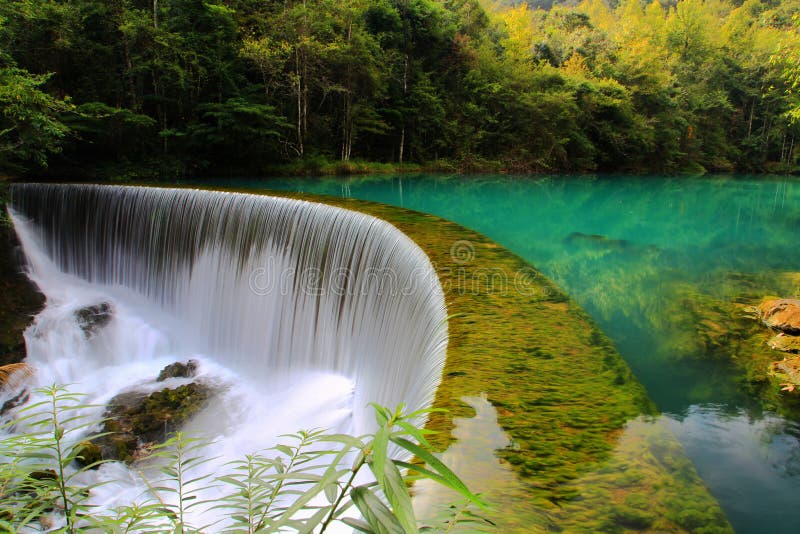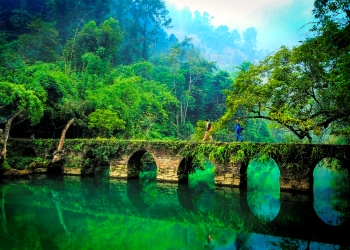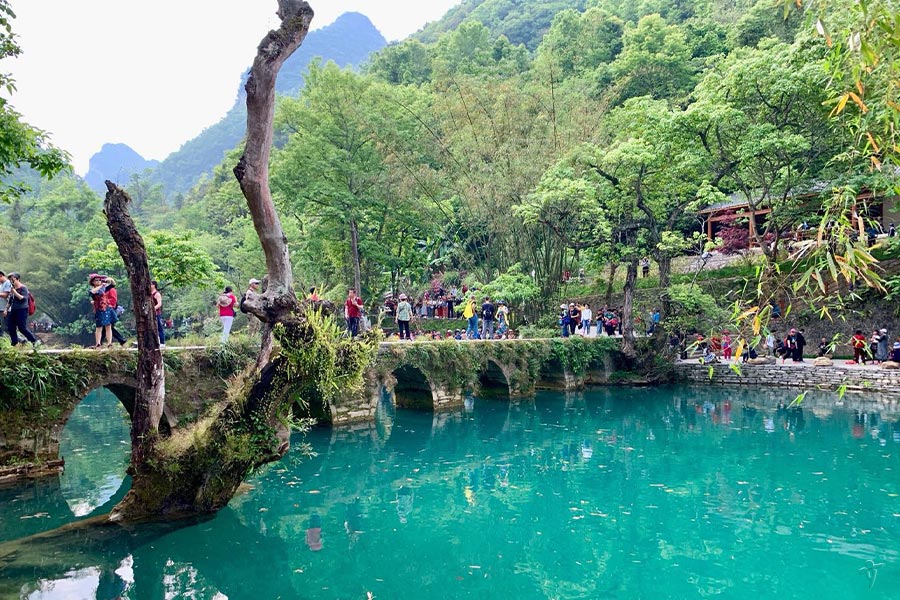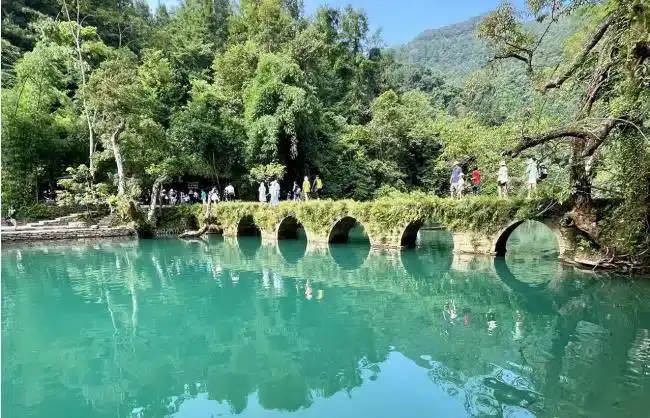A Complete Guide to Exploring Libo Xiaoqikong Scenic Area

An Essential Guide to Visiting Libo Xiaoqikong Scenic Area
Nestled among the stunning karst peaks of Guizhou, the Libo Xiaoqikong Scenic Area is a hidden gem that beckons to travelers seeking an escape into nature’s artistry. Often referred to as the “Emerald of the Earth,” this enchanting destination is a harmonious blend of lush landscapes, cascading waterfalls, and rich cultural heritage. Here, adventure meets tranquility, inviting you to explore its winding paths, ancient bridges, and serene lakes.
As you traverse this picturesque wonderland, you’ll discover the iconic seven-arched bluestone bridge that elegantly spans the roaring river, a testament to the region’s historical significance. The vibrant hues of emerald waters reflect the sky, while the sounds of nature serenade you, creating a truly immersive experience. With its diverse flora and fauna, mesmerizing waterfalls, and the captivating charm of the local Tujia and Yao cultures, Libo Xiaoqikong offers an unforgettable journey for nature lovers, photographers, and culture enthusiasts alike.
Plan your visit to coincide with the milder months from April to October, when the weather is perfect for hiking and exploration. Whether you’re seeking adventure among the 68-tiered waterfalls or a peaceful moment at the serene Wolongtan Pond, Libo Xiaoqikong invites you to step into a world that feels like a fairy tale come to life. Prepare to be captivated by breathtaking landscapes and the warmth of local hospitality as you create memories that will last a lifetime.
In This Guide
- An Essential Guide to Visiting Libo Xiaoqikong Scenic Area
- The Rich History and Legends of Libo Xiaoqikong Scenic Area
- Main Highlights: What You Absolutely Can’t Miss
- Planning Your Visit: A Practical Guide
- Tickets: Prices, Booking, and Tips
- How to Get There: A Complete Transportation Guide
- Local Cuisine and Accommodation Nearby
- Frequently Asked Questions
- Final Thoughts on Your Trip
The Rich History and Legends of Libo Xiaoqikong Scenic Area
Nestled within the breathtaking karst peaks of Guizhou Province, Libo Xiaoqikong Scenic Area is not just a feast for the eyes but also a rich tapestry of history and culture. This enchanting landscape is steeped in legends that echo through its lush valleys and towering cliffs, drawing visitors into a world where natural beauty intertwines with the stories of ancient peoples.
The area is most famously known for its Seven Small Arches, a stunning bluestone bridge that has stood for centuries, witnessing the passage of time and the evolution of the surrounding environment. This bridge is not merely a structure; it is a symbol of resilience and harmony, reflecting the ingenuity of the Tujia and Yao ethnicities that have called this region home for generations. They have woven their cultural narratives into the very fabric of the landscape, with folklore that speaks of spirits residing in the waterfalls and ancient trees, guardians of the natural wonders that attract travelers from around the globe.
Archaeological findings suggest that the region has been inhabited since the Neolithic period. Artifacts unearthed from the area, including pottery and tools, provide insights into the lives of early inhabitants who thrived in this verdant paradise. As you stroll through the scenic area, you may find remnants of ancient pathways and stone structures, remnants of a time when the land was revered not only for its beauty but also for its resources.
One of the most captivating legends associated with Libo Xiaoqikong is that of the Dragon King. Local lore tells of a powerful dragon that once ruled over the waters of the region, ensuring bountiful rains for the crops and protecting the villagers from drought. In times of need, the villagers would conduct rituals at the water’s edge, offering their gratitude and seeking blessings. The dragon’s presence is believed to linger, particularly around the tranquil waters of Mandarin Duck Lake, where many claim to have seen shimmering scales beneath the surface.
The area’s natural wonders, such as the stunning Cuigu Waterfall and the serene Wolongtan Pond, have also been the backdrop for countless tales of love and longing. The reflections in the crystal-clear waters often evoke stories of star-crossed lovers who met in secret, their whispers carried off by the gentle breeze. These narratives of romance and adventure have captivated not only locals but have also inspired poets and artists, making Libo Xiaoqikong a source of creative inspiration for centuries.
As you explore the winding paths and vibrant landscapes of Libo Xiaoqikong, take a moment to connect with the history that surrounds you. Each rock, bridge, and waterfall holds a story waiting to be discovered, a reminder of the enduring relationship between nature and humanity. This scenic area is more than a travel destination; it is a living gallery of the past, offering a unique glimpse into the rich cultural heritage of Guizhou Province. Whether it’s the architectural marvels of the ancient bridges or the whispers of legends in the rustling leaves, the Libo Xiaoqikong Scenic Area invites you to immerse yourself in its remarkable history and the enchanting legends that continue to breathe life into this extraordinary locale.

Libo Xiaoqikong Scenic Area.
Main Highlights: What You Absolutely Can’t Miss
When you step into the enchanting world of Libo Xiaoqikong Scenic Area, you’ll find yourself surrounded by a mesmerizing tapestry of nature’s finest creations. From lush karst landscapes to crystal-clear waters, this hidden gem in Guizhou, China, is a paradise for both nature lovers and adventure seekers alike. Here’s a curated list of must-see highlights that will make your visit unforgettable.
Ancient Seven-Arch Bridge (七孔桥)
The centerpiece of the area, the ancient Seven-Arch Bridge, is a stunning example of traditional architecture, crossing the rushing waters of the river. This bluestone marvel not only offers a perfect photo opportunity but also serves as a gateway to the breathtaking scenery that surrounds it. As you walk across, take a moment to appreciate the intricate carvings and the vibrant atmosphere steeped in local history.
Laya Waterfall (拉雅瀑布)
Prepare to be awed by the Laya Waterfall, one of the most picturesque spots in the scenic area. With water cascading dramatically down rocky cliffs, this waterfall is perfect for a refreshing dip on a hot day or simply soaking in the tranquility of nature. The sound of the water crashing below adds to the serene ambiance, making it an ideal spot for relaxation and reflection.
68-Tiered Waterfall (68级瀑布)
Another highlight not to be missed is the breathtaking 68-tiered waterfall. This natural wonder showcases a series of cascading flows, each tier creating its own unique beauty. Trekking along the paths that lead to the waterfall will reward you with stunning views and the invigorating sound of water tumbling over rocks. It’s a fantastic spot for photography, particularly in the early morning light when the water glistens like diamonds.
Mandarin Duck Lake (鸳鸯湖)
A serene oasis within the scenic area, Mandarin Duck Lake is a tranquil escape where you can paddle a bamboo raft amidst stunning landscapes. The lake is known for its clear waters and lush surroundings, making it a perfect backdrop for a peaceful afternoon. Birdwatchers will also delight in the variety of wildlife that frequents the area, including the beautiful mandarin ducks that lend their name to the lake.
Wolongtan Pond (卧龙潭)
Often called the “Emerald of the Earth,” Wolongtan Pond is a must-visit for its striking turquoise waters and lush surroundings. It’s an idyllic spot for a leisurely walk or a picnic while enjoying the vibrant flora. The reflections of the karst peaks in the water create an ethereal atmosphere, making it a popular spot for photographers seeking to capture the essence of Libo.
Water Forest (水上森林)
Experience a unique ecosystem at the Water Forest, where trees rise majestically out of the water, creating a mystical landscape. Walking along the boardwalks, you’ll feel as if you’ve stepped into a fairy tale. This area is perfect for those who appreciate biodiversity and wish to immerse themselves in nature. Keep an eye out for the local wildlife that calls this forest home.
Cuigu Waterfall (翠谷瀑布)
A hidden gem, Cuigu Waterfall offers a quieter experience compared to its larger counterparts. Nestled in a lush valley, this waterfall is surrounded by verdant greenery and provides a perfect spot for a picnic. It’s less crowded, allowing for a more intimate connection with nature.
Crouching Dragon Pool (卧龙潭)
The Crouching Dragon Pool is another enchanting location where you can enjoy the tranquil waters and the stunning backdrop of karst formations. Ideal for relaxation and contemplation, the pool provides a serene environment to recharge before continuing your adventure.
Local Tujia and Yao Culture
While the natural beauty is breathtaking, don’t forget to explore the rich cultural heritage of the Tujia and Yao ethnic groups in the area. Engage with the locals, savor traditional dishes like sour soup fish and grilled fish, and immerse yourself in the vibrant traditions that shape this stunning region.
Visiting Libo Xiaoqikong Scenic Area is like stepping into an enchanting storybook filled with natural wonders and cultural treasures. Whether you are hiking through lush forests, marveling at cascading waterfalls, or simply enjoying the tranquility of the lakes, every moment spent here will be a cherished memory. Make sure to bring your camera, comfortable shoes, and an adventurous spirit to fully embrace the beauty of this hidden paradise!

Libo Xiaoqikong Scenic Area.
Planning Your Visit: A Practical Guide
Planning a trip to Libo Xiaoqikong Scenic Area promises a delightful escape into one of China’s natural treasures. Nestled in the picturesque mountains of Guizhou, this stunning area is celebrated for its enchanting landscapes, clear waters, and rich cultural heritage. Here’s your practical guide to making the most of your visit.
Getting There
By Air: The nearest airport is Libo Airport, which has flights connecting to major cities. From the airport, you can take a taxi or book a shuttle to reach the scenic area.
By Train: High-speed rail services are available to Libo Station, making it a convenient option for travelers. Once you arrive, local transport options like buses and taxis can take you to the entrance of the scenic area.
Opening Hours and Tickets
Libo Xiaoqikong Scenic Area is open daily from 8:00 AM to 4:30 PM. It’s important to note that ticket sales end at 4:00 PM, so plan your visit accordingly.
- Ticket Prices:
- Xiaoqikong Scenic Area: CNY 120 per person
- Daqikong Scenic Area: CNY 55 per person
- Maolan National Nature Reserve: CNY 50 per person
Best Time to Visit
For the most pleasant weather and stunning scenery, plan your visit between April and October. During these months, the average temperature hovers around 20-25°C, making it ideal for outdoor activities.
Suggested Itinerary
Day 1: Arrival and Exploration
- Morning: Arrive at Libo Airport or High-speed Rail Station and check in to your hotel.
- Afternoon: Begin your adventure in the Xiaoqikong Scenic Area. A recommended route includes:
- Tonggu Bridge
- Xiaoqikong Ancient Bridge
- Laya Waterfall
- 68-tiered Waterfall
- Water Forest
- Cuigu Waterfall
- Mandarin Duck Lake
- Wolongtan Pond
- Evening: Indulge in local delicacies like sour soup fish and grilled fish at a nearby restaurant.
Day 2: Nature and Culture
- Morning: Head to Daqikong Scenic Area to admire Tiansheng Bridge and explore Yaofeng Cave and Kongbu Gorge.
- Afternoon: Choose between a hike in Maolan National Nature Reserve to experience the primeval forest or visit Yaoshan Ancient Village to immerse yourself in local Yao culture.
- Evening: Return to your hotel for a restful night.
Day 3: Leisure and Departure
- Morning: After a leisurely breakfast, explore Libo Ancient Town for local souvenirs.
- Afternoon: Depart according to your travel schedule.
Accommodation Options
Luxury Stays
- Libo Xiaoqikong Scenic Spot Ruijing Hotel: Located at the east gate of the scenic area, it offers elegant accommodations and top-notch service.
- Libo Zhangjiang Tribe Hotel: Close to the Zhangjiang River, this hotel boasts luxurious decor and a rich ethnic atmosphere.
Comfortable Choices
- Libo Xiaoqikong Shanshui Hotel: Situated at the west gate, this hotel provides a serene environment and excellent value.
- Libo Ancient Town Inn: Perfect for budget travelers, this inn features charming decor and affordability.
Travel Tips
- Footwear: Wear comfortable shoes as there will be a lot of walking involved.
- Sun Protection: Bring sunscreen and insect repellent, especially during the summer months.
- Environmentally Friendly Travel: Respect the natural surroundings by not littering and following guidelines.
Culinary Delights
While in Libo, make sure to try local dishes such as:
– Sour Soup Fish
– Libo Rice Noodles
– Tofu Grilled Fish
– Yao “Bopiji” Banquet
Personalized Suggestions
Feel free to adjust your itinerary based on your interests and time. If you’re a photography enthusiast, visiting early morning or late evening can provide beautiful lighting for stunning photos. Consider adding activities like river rafting or exploring nearby attractions if time permits.
With its breathtaking scenery and rich cultural offerings, Libo Xiaoqikong Scenic Area is a must-visit destination for anyone looking to experience the natural beauty of China. Enjoy your adventure in this earthly paradise!

Libo Xiaoqikong Scenic Area.
Tickets: Prices, Booking, and Tips
Planning your visit to the Libo Xiaoqikong Scenic Area? Here’s everything you need to know about tickets, booking options, and some handy tips to ensure a smooth experience.
Ticket Information
- Ticket Price: Admission to the Libo Xiaoqikong Scenic Area is CNY 120 per person. If you’re planning to explore the nearby attractions as well, here are the prices for those:
- Daqikong Scenic Area: CNY 55 per person
-
Maolan National Nature Reserve: CNY 50 per person
-
Opening Hours: The scenic area is open from 8:00 AM to 4:30 PM. Be sure to arrive early, as tickets are sold until 4:00 PM, and admission closes promptly at 4:30 PM.
Booking Tickets
Tickets can be conveniently purchased through various platforms, including online travel agencies like Trip.com, where you can also find additional information and customer reviews. It’s advisable to book your tickets in advance, especially during peak tourist seasons (April to October), to avoid any disappointment.
Tips for a Seamless Visit
-
Arrive Early: To make the most of your day, plan to arrive at the scenic area as soon as it opens. This allows you to enjoy the stunning landscapes with fewer crowds and capture the best photographs.
-
Wear Comfortable Shoes: The scenic area involves a lot of walking along trails and around the beautiful water features. Comfortable footwear is essential for a pleasant experience.
-
Stay Hydrated and Sun-Protected: Bring water with you, as you’ll be exploring outdoors for several hours. Don’t forget to apply sunscreen and wear a hat, especially during the summer months.
-
Plan Your Route: Popular highlights include the ancient seven-arched bridge, Laya Waterfall, and the mesmerizing 68-tiered waterfall. A suggested route to maximize your visit is:
- Start at: Tonggu Bridge
-
Continue to: Xiaoqikong Ancient Bridge → Laya Waterfall → 68-tiered Waterfall → Water Forest → Cuigu Waterfall → Mandarin Duck Lake → Wolongtan Pond.
-
Enjoy Local Cuisine: After a day of exploring, treat yourself to local delicacies such as sour soup fish and Libo grilled fish to round off your experience.
By following these guidelines, you’re set for an unforgettable adventure in one of China’s most beautiful natural landscapes. Enjoy your journey through the breathtaking Libo Xiaoqikong Scenic Area!
How to Get There: A Complete Transportation Guide
Reaching the enchanting Libo Xiaoqikong Scenic Area is an adventure in itself, seamlessly linking travelers to one of China’s most stunning natural landscapes. Whether you’re arriving by air or rail, this guide will help you navigate your way to this emerald gem nestled in the heart of Guizhou province.
By Air
The nearest airport to Libo Xiaoqikong is Libo Airport (LIA), which offers flights to and from several major Chinese cities. Here’s how to get there:
- From Libo Airport:
- Taxi: The easiest way to reach the scenic area from the airport is to take a taxi. The ride takes approximately 30 minutes and costs around 60-80 RMB (9-12 USD). Make sure to have the destination written in Chinese, as many drivers may not speak English.
- Shuttle Services: Some hotels offer shuttle services for guests, so check with your accommodation in advance for availability.
By Train
Libo High-Speed Railway Station is well-connected with major cities such as Guiyang, Nanning, and Guilin. Here’s the process to follow:
- From Guiyang:
-
Take a high-speed train to Libo Station. The journey takes about 2-3 hours, depending on the train type. Tickets range from 100-200 RMB (15-30 USD) based on the class of service.
-
From Libo Station to Xiaoqikong Scenic Area:
- Taxi: A taxi from the train station to the scenic area will take about 20 minutes, costing around 30-50 RMB (5-8 USD).
- Tourist Bus: Look for the designated tourist buses that frequently run from the train station to the scenic area. This is a budget-friendly option and costs approximately 10 RMB (1.50 USD) per person.
Getting Around
Once at the Libo Xiaoqikong Scenic Area, you’ll find that the best way to explore is on foot. The area is designed for walking, with well-marked paths leading to the major attractions. Here are a few tips to enhance your experience:
- Comfortable Footwear: Be sure to wear sturdy shoes as the terrain can be uneven.
- Guided Tours: If you prefer a more structured experience, consider joining a guided tour. Many local operators provide packages that include transportation, meals, and expert commentary on the area’s natural and cultural history.
Local Transportation
If you wish to explore beyond Xiaoqikong, consider the following options:
- Car Rentals: For those who like to explore at their own pace, renting a car is an option. Check local rental services in Libo or at the airport/train station.
- Bicycle Rentals: Cycling is a delightful way to experience the scenic beauty. Look for bicycle rental shops in Libo.
Important Tips
- Currency: Ensure you have enough cash on hand, as not all establishments accept credit cards.
- Language: Having a translation app handy can be useful, as English is not widely spoken in rural areas.
- Weather: The best time to visit is from April to October when the weather is most pleasant. Summers are particularly cool, averaging around 25°C (77°F), making it a perfect escape from the heat.
With this comprehensive transportation guide, you’re well-equipped to embark on your journey to the breathtaking Libo Xiaoqikong Scenic Area. Enjoy the stunning landscapes and immerse yourself in the rich culture of this hidden paradise!

Libo Xiaoqikong Scenic Area.
Local Cuisine and Accommodation Nearby
When visiting the breathtaking Libo Xiaoqikong Scenic Area, international travelers will find an array of delightful local cuisines and comfortable accommodations to enhance their experience. Here’s a guide to savor the flavors and find the perfect place to rest.
Culinary Delights
-
Sour Soup Fish (酸汤鱼): This signature dish from Guizhou is a must-try. The fish is simmered in a tangy broth made from pickled vegetables and spices, offering a unique blend of flavors that embodies the region’s culinary heritage.
-
Grilled Fish (烤鱼): Freshly grilled fish, often seasoned with local herbs and spices, is another popular choice. Enjoy it at one of the many riverside eateries, where you can savor the taste while enjoying the stunning natural scenery.
-
Libo Rice Noodles (荔波米线): These rice noodles are a staple in the local diet. Typically served in a rich broth with various toppings, they offer a hearty and satisfying meal after a day of exploring.
-
Yao “Bopiji” Banquet: For a more immersive experience, consider indulging in a traditional Yao banquet. This feast includes a variety of dishes that showcase the local ethnic culture, often served in a communal style.
-
Tofu Grilled Fish: Combining the delicate flavors of fish and the unique texture of tofu, this dish is a local favorite and a testament to the region’s creativity in cuisine.
Where to Stay
-
Libo Xiaoqikong Scenic Spot Ruijing Hotel: Located conveniently at the east gate of the Xiaoqikong Scenic Area, this luxury hotel offers stunning views and first-class amenities. Guests can enjoy beautifully designed rooms and exceptional service, making it a perfect choice for those looking to indulge.
-
Libo Zhangjiang Tribe Hotel: Nestled near the Zhangjiang River, this hotel boasts luxurious decorations and a rich ethnic atmosphere. Its proximity to the scenic area ensures easy access while providing a tranquil retreat.
-
Libo Xiaoqikong Shanshui Hotel: Situated at the west gate of the scenic area, this hotel offers a peaceful environment with clean, comfortable rooms at a great value. It’s ideal for travelers who prioritize comfort without breaking the bank.
-
Libo Ancient Town Inn: For those seeking a unique and budget-friendly option, this inn in Libo Ancient Town features charming, antique décor and affordable rates. It’s a perfect spot to immerse yourself in local culture.
-
Bamboo Lodge Inn: Located within the scenic area, this lodge offers a cozy atmosphere and the convenience of easy access to the attractions. It’s an excellent choice for those wanting to stay close to nature.
Tips for Travelers
- Best Time to Visit: April to October offers the most pleasant weather and vibrant scenery.
- Local Transportation: The area is well-connected by high-speed rail and local buses, making it easy to navigate.
- Walking Essentials: Comfortable shoes are a must, as the scenic area involves a significant amount of walking.
Whether you’re feasting on local delicacies or resting in a cozy lodge, your visit to Libo Xiaoqikong Scenic Area promises to be a memorable adventure filled with culinary delights and comfortable accommodations.

Libo Xiaoqikong Scenic Area.
Frequently Asked Questions
-
What are the opening hours for Libo Xiaoqikong Scenic Area?
The scenic area is open daily from 8:00 AM to 4:30 PM. Please note that tickets are available for purchase until 4:00 PM, and admission ends promptly at 4:30 PM. -
Do I need to purchase tickets in advance?
While it’s not mandatory to buy tickets in advance, it is highly recommended, especially during peak travel seasons, to ensure your entry. Tickets can be purchased on-site or through various travel apps. -
How much do tickets cost?
Admission to Libo Xiaoqikong Scenic Area is CNY 120 per person. If you plan to visit nearby areas like Daqikong Scenic Area or Maolan Nature Reserve, tickets are CNY 55 and CNY 50 respectively. -
What are the must-see attractions within the area?
Don’t miss the iconic Seven-Arch Bridge, the breathtaking 68-tiered waterfall, and the tranquil Wolongtan Pond. Other highlights include the Water Forest, Mandarin Duck Lake, and the Crouching Dragon Pool. -
What is the best time of year to visit?
The optimal time to visit is between April and October when the weather is pleasant, and the natural scenery is at its most vibrant. Summers are particularly cool, with temperatures averaging around 25°C (77°F). -
What should I wear and bring when visiting the area?
Comfortable walking shoes are essential due to the extensive walking involved. It’s also wise to wear sunscreen, carry mosquito repellent, and bring a reusable water bottle to stay hydrated while exploring. -
Are there dining options available within the scenic area?
Yes, there are several food stalls and restaurants where you can enjoy local specialties such as sour soup fish, grilled fish, and Libo rice noodles. It’s a great opportunity to indulge in the region’s unique culinary offerings. -
How can I get to Libo Xiaoqikong Scenic Area?
You can reach Libo via Libo Airport or by taking a high-speed train to Libo Station. From either location, local tourist buses or taxis are readily available to transport you to the scenic area.
Final Thoughts on Your Trip
As your adventure at Libo Xiaoqikong Scenic Area comes to an end, take a moment to reflect on the breathtaking beauty that surrounds you. This hidden gem, often referred to as the “Emerald of the Earth,” offers a unique blend of stunning karst landscapes, cascading waterfalls, and vibrant cultural heritage that leaves a lasting impression on every traveler. The enchanting sights of the ancient seven-arched bridge and the tranquil waters of Wolongtan Pond remind us of nature’s artistry, while the rich traditions of the Tujia and Yao people provide a glimpse into the region’s rich history.
Whether you spent your days trekking through lush forests, basking in the serenity of Mandarin Duck Lake, or indulging in the local culinary delights, each moment here has been an opportunity to connect with the natural world and the vibrant culture of Guizhou. As you prepare to leave, carry with you the memories of the breathtaking landscapes and the warmth of the local hospitality.
Libo Xiaoqikong is more than just a destination; it’s a sanctuary for the soul, a place where the beauty of nature harmonizes with the simplicity of life. So, until your next adventure, may the spirit of this magical place continue to inspire your travels and fill your heart with wonder. Safe travels!